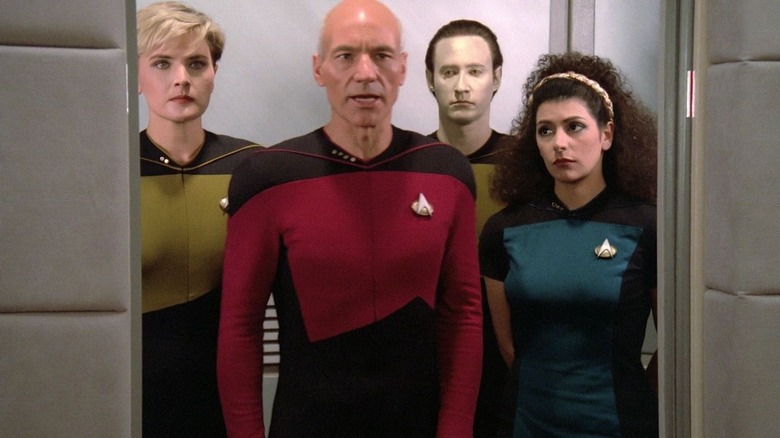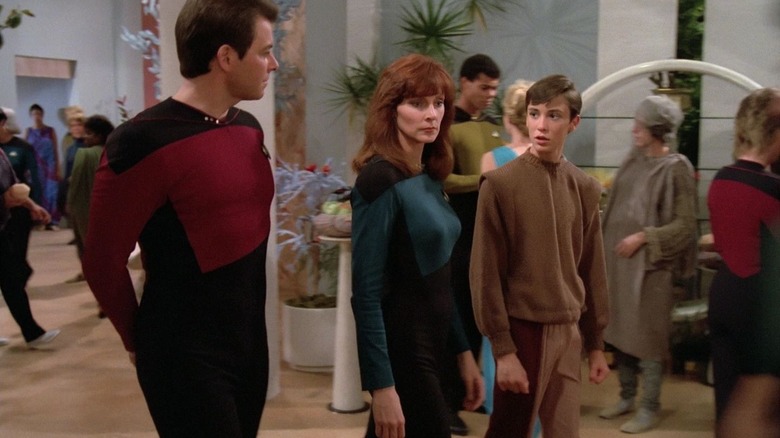Patrick Stewart Threatened Paramount With A Lawsuit Over One Star Trek Costume
In the first two seasons of "Star Trek: The Next Generation," the crew of the Enterprise-D wore zip-up, full-body jumpsuits as their uniforms. The jumpsuits had no collars and sported a diamond-shaped pattern that draped over the shoulders. They were very pajamas-like, but didn't look very cozy. Indeed, they weren't very flattering either. In Larry Nemecek's invaluable sourcebook "The Star Trek: The Next Generation Companion," actor Jonathan Frakes noted that the jumpsuit uniforms were so unforgiving that if one ate an extra donut for breakfast, everyone could see it for the rest of the day.
It wouldn't be until the show's third season that the uniforms would be redesigned. In addition to a small collar, the top portion of the uniform was replaced by a boxier, more roomy torso that zipped up the back. Although the actors can be seen constantly readjusting the new uniforms (in what came to be known as "the Picard maneuver"), they looked a heck of a lot more comfortable. The redesign was carried through to the end of the series.
For a while, though, everyone was constantly irritated by the jumpsuits. In fact, the jumpsuits were so tight and slung so snugly over the actors' shoulders that several of them started to suffer mild back problems. It was hard to stand up straight.
Indeed, the jumpsuits were so hard on Patrick Stewart's back that the Picard actor threatened to sue Paramount over the costume's designs. Stewart talked to Newsweek in 2008 about how much he hated the uniforms, and how he suspected they were all deliberately made in too-small sizes. He was relieved when complaints forced the studio to change the Starfleet uniforms with real human bodies in mind.
The Next Generation's season 1 costumes were a problem
When asked if he ever got sick of the season 1 jumpsuit he had to wear, Stewart was rather frank:
"Sick of it? I came to loathe it. We actually got rid of it after the second season thanks to my chiropractor, who said if they don't take you out of that costume we are going to slap a lawsuit on Paramount for the lasting damage done to your spine. [...] They were made from Lycra and one size too small. The producers wanted to have a smooth, unwrinkled look. It put a terrible amount of strain on the shoulders, neck and back."
Imagine wearing a lightweight wetsuit every day to work, and you may have an idea of what Stewart and his co-stars had to go through. In early episodes of the series, some of the cast members, male and female, were permitted to wear minidresses (seen on Troi actor Marina Sirtis in the photo above), but those were abandoned rather quickly. Perhaps they were seen as too much of a sexist throwback to the minidresses worn by the women on "Star Trek: The Original Series."
The lawsuit, incidentally, was no idle threat. Stewart actually made moves toward legal action and personally appealed to show creator Gene Roddenberry, hoping to get the uniforms redesigned. The actor went into a little more detail in his excellent autobiography "Making It So: A Memoir." The first version of the "Next Generation" uniforms were designed by William Ware Theiss, the Emmy-winning creator of the original "Star Trek" uniforms. The redesigned uniforms were constructed by longtime "Trek" costumer Robert Blackman, and, according to Stewart, they were a mercy.
Stewart lawyering up did the trick
In "Making it So," Stewart wrote:
"Our one-piece uniforms, created by the original 'Star Trek's' costume designer, William Ware Theiss, were made of spandex and deliberately cut one size too small so that they never wrinkled and kept our bodies on constant display [...] The problem was these uniforms, beyond their leaving little to the imagination, were constricting to the point of causing pain [...] I campaigned to Gene directly to switch to different uniforms but my pleas fell on deaf ears."
It was then that Stewart was encouraged to get litigious. He was in Los Angeles, now, after all, and lawyering up is the town's equivalent of a friendly handshake. He continued:
"[M]y agent, Steve Dontaville, came up with a brilliant idea: I would consult my doctor and ask him to make an appeal, as a medical professional, to change the uniforms. Steve also threw his weight around, intimating to the Paramount execs that if the situation were not remedied, he would bring suit against them for any muscular and joint damage I suffered."
No legal papers were actually filed, of course, but Stewart's legal posturing was enough to rattle Paramount a little bit. Blackman constructed the newer, more comfortable uniforms, and all was well. Frakes no longer had to worry about extra donuts and, more importantly, no one was going to have to go home with a sore back anymore.
Also, to offer a brief editorial, Blackman's uniforms looked more formal. Theiss' uniforms looked fine, but they possessed a throwback sci-fi quality that made "Next Generation" seem a little dated. The newer uniforms felt a little more timeless.


